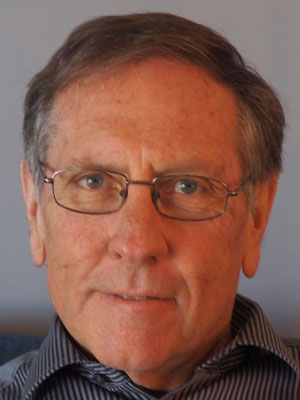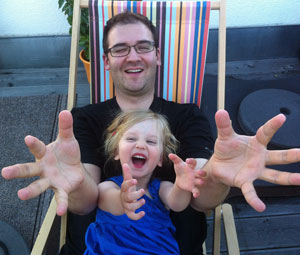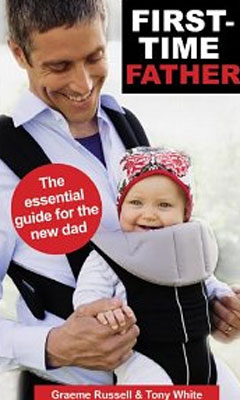Graeme Russell is a consultant on diversity, flexibility, work / life, creative learning, fatherhood and organisational change who has been involved in research, writing and workplace policy development on men, fathers and work for over 30 years. He has both a national and an international reputation, having previously been an Associate Professor in Psychology at Macquarie University where he taught organisational change and development, flexibility and diversity. He began his consulting work with his pioneering approach to work/life and diversity in Alcoa, Caltex Oil, Esso and Nestle, before going on to work in a range of industries and organisations in Australia, New Zealand, Europe, US, Singapore, Japan, Korea and China.

“…I’ve never come across a man yet who has taken significant leave or worked flexibly who in the long run could say it’s had a negative impact on his career…”
From Pure Mathematics to Experimental Psychology to diversity and fatherhood
My career to date is quite varied. I started out with a degree in Pure Mathematics and a Ph.D. [Doctor of Philosophy] in Experimental Psychology and then I had children. Having a first child changed my career in a very significant way and then I became interested in fatherhood, work / life issues and particularly gender equality issues.
So from there I spent a lot of my time in an academic job, doing research on gender equality and fatherhood, and I’ve written quite a lot on those topics and also at the same time developed a consulting practice. So I have consulted in organisations for the past 30 years on diversity, flexibility, gender equality, not so much on fatherhood, but that’s been part of the equation.
I suppose it’s shifted a bit in the sense that organisations haven’t always been particularly interested in fatherhood and what’s more haven’t seen that as being a vital part of the gender equality picture.
Diversity over the past 30 years
What happened with a lot of this if you take my first interest in it and how I got involved in organisations, it was framed as work / life and equal employment opportunity. It’s changed dramatically since then.
I think that probably different countries have different approaches to it. I think that diversity became a key issue in the United States with affirmative action. In other countries like Australia, it developed more out of gender issues and that has morphed into broader culture, religion and so on.
There’s gender, flexibility, work / life and now you’re used to having Equal Employment Opportunity Officers and you’ve got Diversity and Inclusion Managers. It certainly is the norm. It’s a rare global organisation that does not have some statement on diversity.
In Australia the companies that list on the stock exchange for example have to have a diversity policy and a diversity strategy. It’s a requirement in their reporting. The Workplace Gender Equality Act that certainly covers organisations with 100 or more employees.
Fathers taking an active role in their children’s upbringing
I still see that organisations aren’t taking fatherhood as seriously as they probably could in terms of getting the benefits of it. There’s been a shift in the sense that there are more dads today who are warmed up to be actively involved. There are more dads who are in a diversity of relationship and family situation, where they’re in partnered relationships where both are in the paid workforce, so all of that shift in terms of the personal dynamics.
What hasn’t happened so much though it that organisations haven’t shifted as much in the sense of recognising that there is a strong group of dads who are making decisions around their work on the basis that there are opportunities to be involved with their children.
Workplaces supporting fathers equal better staff engagement: No such thing as the ‘ideal’ worker

We also know from the research that when you do have that kind of dual focus in your life, for a man who’s both engaged in his work and engaged in being a dad, it has a positive impact in terms of their own wellbeing and their capacity to contribute to the workplace over a longer period of time.
I think workplaces spend too much time focusing on that ‘ideal’ worker who’s fully committed and available all the time, works long hours, but that’s not the worker in the end who’s going to give you that innovation and that kind of creativity. It’s more somebody who is having some kind of other aspect to their life and fatherhood is a way that helps motivate lot of men to contribute more in the workplace.
The evolution of the roles of working fathers in different cultures
It’s hard to say in terms of what’s happening in different countries. There is a lot more interest globally in fatherhood and the corporate father aspect of it, so in the United States, Boston College for example has a lot of focus on supporting fathers. If you go to work in Sweden, they’ve had a strong focus on that and the impact it has on the corporate area.
In the UK it’s funny – 10 or 15 years ago Australia was ahead of the game with regards to dad policies and practices – but the UK in terms of paid paternity leave and more gender equality and some of those aspects of leave and providing services has probably jumped ahead a little bit from where we are.
It is still the case that in companies in Australia I’m more familiar with that all of our policies around gender equality are not framed in terms I’d consider to be ‘genuine’ gender equality, so in relation to paid work and caring. I think that doesn’t translate into a totally supportive environment for dads to be the kind of active parents they would like to be, but there is a general shift that’s going on.
One of the things we know from the research that’s be done globally on these issues is that if a country has that broader gender equality framework, it does translate into a different approach for corporations and it provides that support for men to be more actively involved. What I still don’t ‘get’ and the frustrating part from my point of view is why organisations don’t see this as a potential benefit and an opportunity to position themselves completely differently with regards to gender equality and focusing on the value of fatherhood.
Enormous opportunity for organisations that allow part-time workers to maintain a career pathway
It’s an enormous opportunity waiting there for organisations and men are warmed up to it. Why wouldn’t they do it? I really don’t know. Any organisation that adopts a flexible approach to careers, a long term one for both women and for men – I think there are enormous benefits to that.
At the moment a lot of organisations have complete rigidity with regards to careers and if for example you take part-time work – all the evidence shows that it’s a rare organisation that enables people who work part-time to maintain a career pathway.
Fear and expectation around flexible work – not the reality
For a lot of men, they look at that and they think, “That’s probably not what I’m going to do,” because it will have an impact on careers, although it is the case that I’ve never come across a man yet who has taken significant leave or worked flexibly who in the long run could say it’s had a negative impact on his career. There is still that kind of fear and expectation that it may have a negative impact on your career.
The thing about it I suppose is that when organisations do open this up and I quote the example of a guy who worked in the mining industry who was in a global job and he was an actively involved dad. His organisation hadn’t thought much about what that active involvement would mean in terms of his career and his job, but he reached a point where he said, “I’ve had enough of this,” so he went to his organisation and said, “I want to renegotiate my terms of employment.”
Now he was a very senior manager, but the interesting thing about it was that they were able to find a solution for this global manager who had all these direct reports around the world. He put a priority on being an actively involved father and getting a more balanced gender equality aspect to his personal relationship. Now the outcome from that was an enormously positive change in the way that they designed their business, the way that they designed jobs.
This is a really key part about this whole equation – if we’re not prepared to redesign jobs and look at ways that both men and women can go in and out in terms of careers, I think again it’s a lost opportunity. They’re just making an assumption it’s the way the world should work.
Organisations supporting working fathers: Benefiting by getting different human beings

What you’re doing there is missing out on the best people for the jobs because you’re just promoting people on the basis of their capacity to be available and on the basis of their demographics, and I still don’t understand why that’s good for organisations. The argument applies both to women and to men.
Career development and work / life programmes for women and men
I do some radical things at times! I run a programme called “Men at Work”, which is a programme that actively engages men around their work / life and fatherhood and so that’s something that is very different.
Lots of organisations provide career development programmes for women but don’t look at the other side of it in terms of how they can support men to engage more actively in caregiving and to look after their own wellbeing. This is something that is completely outside of that traditional career development framework.
I thought diversity was about women
That’s a programme we’ve run in many organisations and it is something that is quite radical. Often it’s the diversity manager who looks to put that in place and sometimes organisations think, “Why are we doing this? I thought diversity was about women,” and you say, “Well this is part of that equation. It’s about gender equality.”
So apart from that what you do is you find individual managers, and this is one of the problems that we’ve got, how this applies through an organisation. Individual managers might structure a situation that’s very different, enabling men and dads to care for their children or to have that open career conversation, but it’s a rare CEO or very senior manager who puts their hand up and engages actively in caregiving or makes that public.
I see more senior men who are prepared to put their hands up to say they want to be actively involved dads, whereas previously that wouldn’t have been seen as being a reasonable part of the conversation to have. It goes in and out. I’ve been involved in organisations where they’ve looked at the transition to parenthood and engaged all men in the organisation who were new dads by doing the same kinds of things as they do for new mums – providing support for them etc.
This is the programme that was designed around an organisation engaging directly with new dads because the assumption there was that if they engaged with them at that stage of becoming a new dad that might translate into a different approach in the organisation.
I’ve put that in place in a couple of organisations and it hasn’t always been sustained. That’s an interesting one. If they do adopt that approach and stick with it I think the benefits to them are enormous.
Need to do more than focus on senior men as a way of changing an organisation
I have a bit of a problem with some of the approaches that focus on senior men as a way of changing an organisation in the sense of the majority of CEOs are in partnered relationships with women, and I suppose my question is: Why hasn’t that prompted a change? In other words, why isn’t this being framed as a gender equality issue about the nature of their own relationships?
I see a lot of men in these roles who are basically saying, “I now see the light because I have a daughter,” but it doesn’t translate into their own gender equality or the equality in their own relationships in their own lives, and it doesn’t translate into a shift in their own personal reflection or change them as an individual. The majority are in a traditional breadwinner relationship. Why they don’t see that as problematic, why that doesn’t prompt them to shift to greater gender equality, I’m not sure.
Shifting the gender equality paradigm – creative ways of establishing relationships
If you’re going to shift the paradigm, I think exploring alternative, creative ways of establishing relationships – we need more of that. I think we need to see more of the people who’ve been able to craft a different way of doing things, and in terms of power and money, so that’s a very interesting proposition.
You do see lots of situations where people argue, “Well, we’re going to do this as a transition, but in the long term you’ll sacrifice your career because we’ve made an agreement.” We need to look at alternative models. The ThirdPath Institute is a U.S. based group and what they’re trying to do is to create different models of combining work and family / personal life, showcase those and develop a different perspective on it.
Corporate programmes aimed at women – one size doesn’t fit all
I gave a presentation last week at a corporate lunch at a corporate programme aimed at women. There’s a quote that’s been around for a while which is that, “Men will apply for jobs if they have 60% of the qualifications; women will only apply for them if they have 100%.” When you go back and try and look at it that there isn’t a really good evidence base, yet it continues to be repeated, so this session was about that and what can women do.
One of the things that came up was that there is an inner voice and an inner critic and how that plays out in terms of anybody’s decision about whether or not to apply for a job. As part of this they had a very successful man who came in to talk about how he negotiated his career path.
Now on the positive side it was about how he’d moved from one part of the business to another and that’s one of the problems that was felt with regards to progression of women is that often they’re put into categories as part of career paths and they can’t get out of them. A lot of organisations are looking at ways to get out of category based careers as part of their diversity approach, so if you’re an HR person you can’t go anywhere else etc.
It was a good role model from that point of view, however as part of the conversation he introduced the fact that he had a stay at home partner who was the primary caregiver for their children. He pulled out a photograph of his family and said without their support he wouldn’t be where he is now, but I’m sitting there thinking to myself, “You’ve just put in front of these people probably one of the biggest barriers to them applying for jobs,” and that is they don’t have that support in order to do this really big job.
The whole business about gender equality in terms of you as a dad or you as a partner and so on was totally missed in that conversation, and yet it was seen within the corporate environment as an OK thing to do and nobody challenged it.
Patriarchal and patronising models don’t work
The thing that irritates me about all of this stuff is that you finish up with what I consider to be a patriarchal, patronising partnership model too. A lot of organisations have diversity councils, and yet they finish up being with the older, senior males there as patrons, as champions, with a mixed group of females, but the kind of younger male who’s partnered and is working through some of these relationships is missing from that debate and that discussion.
To look at this from a gender point of view from within an organisation, my view about this is you’ve got to look at opportunities for men and women to work together on these issues and to make visible what the barriers are for both women and men rather than just always seeing them as barriers for women. Unless you develop that kind of partnership, I can’t see a lot of progress.
A lot of the things that were put in place to support women like mentoring and other programmes like that, the evidence shows that they don’t work. They don’t in the end shift all that much. Unless we shift the thinking about seeing this as being an issue for both women and men I don’ think it’s going to change much either.
Millennials: A new generation with new values, but not always a voice in the organisation

Time to stop framing diversity in terms of demographics and focusing on unconscious bias?
The shift in diversity really has been around looking at the impact that people from diverse perspectives can have on organisations, so it’s now much more likely that when framing diversity we don’t frame it so much in terms of demographics, but frame it in terms of people who come from diverse backgrounds, cultures, experiences who are going to add something different to an organisation, so it’s all about that diversity in thinking, diversity of problem solving, mental flexibility and so on. Curiosity is another one of those things.
There’s also been an enormous interest globally in unconscious bias. There are many different dimensions to unconscious bias. I see that as being one of the fads at this point in time, that they’re going to solve these problems by making people aware of unconscious bias – most of the work that’s been done shows that no matter how aware you become of it, the way your brain functions and the way that you see things, it is a challenge individually, but conscious bias is probably more prevalent and needs to be worked on as well.
The thing that I find interesting talking about this area is that there is an enormous amount of work that shows that the same kind of skills and behaviours that you need to be innovative and creative and flexible in your thinking are the same type of skills that have a positive impact on getting rid of bias.
I think that organisations are probably now waking up to the fact that they’re a set of behaviours and skills that are far more important than enabling people to be aware of unconscious bias. That’s a shift that I see that’s starting to happen.
Open up the thinking around career paths to reap the benefits of diversity
Unless we open up the thinking in terms of career paths but also what kinds of capabilities and skills people need in order to be successful in different kinds of roles and we stay straight-jacketed in the way this is person is – they’re an HR person or a finance person – we’re not going to reap the benefit of the diversity and all the capabilities that people have.
That, to my mind, is one of the biggest barriers that we have. If you take for example, gender equality, a lot of organisations say, “Well, we don’t have women in profit and loss roles.” That’s not where they’ve come from. That’s not their background and experience.
There are some large organisations now in Australia that are looking very creatively at how they can move women across different roles in the organisation, so they can go from HR into operations, to go from finance into customer relations, and provide an alternative career path which supports them. They’ve identified what current skills people have and also what skills they would need to be successful in that role and then move them on to other things.
There are lots of other organisations who’ve done this in the past. I can give you the example of a women who started out as a lawyer in a big mining company and the CEO had a lot of insight into what to do change things and he moved her into different roles. In the end she finished up as CEO of one of the largest operational sides of the business. No-one would have thought that someone with a legal background could have done that.
Leaders providing an environment where different perspectives can contribute to business outcomes
Diversity is all things diversity and inclusion. We are now seeing much more interest in saying if we want to be successful as an organisation, we have to have leaders who have a different skillset. That skillset goes to inclusion – that is how you work with people who are different and not only make them feel comfortable and feel included and valued, but to provide an environment where different perspectives can contribute to business outcomes. That skillset is quite different from the skillset that a lot of leaders are promoted on at this point in time.
http://www.4points.com.au/about-us/people/graeme-Russell
http://www.4points.com.au/contact






